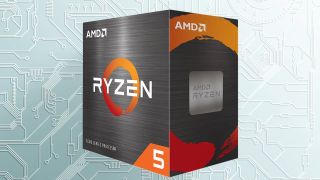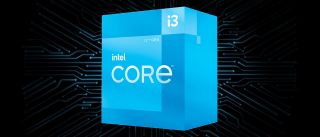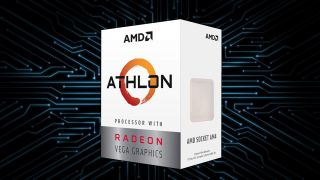Best Budget CPUs of 2024, Tested and Ranked
We've tested several cheap budget CPUs to help you find the right one for your needs and budget.

The best budget CPU landscape was barren for quite some time due to shortages, but the current oversupply means there are plenty of deals to be had for budget CPU models.
Intel's 13th-Gen Raptor Lake processors face off with AMD's Ryzen 7000 lineup, with both vying to offer the best blend of pricing and performance to lead our best CPU for gaming list.
If you're looking to spend at the upper end of the budget spectrum, the Ryzen 5 5600 proves it has an exceptional blend of price and performance, thus earning it the top spot on our list of best budget CPUs. This chip comes with plenty of cores that not only offer leading performance in gaming at its price point, but are also adept enough to chew through intense productivity workloads.
Intel's new 13th-Gen chips only consist of refresh models for the lower-end Core i3 chips, so the Core i3-13100 that falls into the budget price range delivers nearly the same performance as its exceptionally-impressive predecessor, the Intel Core i3-12100.
AMD’s Renoir chips take a new approach of using Zen 2-powered APU silicon with disabled integrated graphics units to tackle the low-end. We reviewed the Ryzen 5 4500 and Ryzen 3 4100 and found that the Zen 2 architecture simply doesn't hold up against today's more modern chips, like the Core i3 models. We can't recommend either of those new AMD chips due to the severe performance and connectivity tradeoffs.
Quick Shopping Tips
Why you can trust Tom's Hardware
- You can't lose with AMD or Intel: Both companies offer good budget chips, and overall CPU performance between comparative parts is closer than it’s been in years. You can see how the chips stack up in our CPU Benchmarks hierarchy.
- Clock speed is more important than core count: Higher clock speeds typically translate to snappier performance in simple, common tasks such as gaming, while extra cores will help you get through time-consuming workloads faster.
- Overclocking a CPU can squeeze more performance out of a budget offering. Intel doesn't have overclocking-capable processors for the sub-$125 market, but AMD's processors allow for tuning, and in most cases, the bundled AMD cooler is sufficient for the task. Automated overclocking features in most motherboards make the process easy, so even the least tech-savvy users can enjoy the benefits.
For even more information, check out our CPU Buyer’s Guide, where we discuss how much you should spend for what you’re looking to do, and when cores matter more than high clock speeds. If you can expand your budget and buy a mainstream or high-end processor, check out our lists of Best CPUs for Gaming and Best CPUs for Workstations. Below, you'll see our favorite budget picks.
Best Budget CPUs in 2024 at a Glance:
Best $100-$140 Budget CPU Pick:
1. Ryzen 5 5600
Best $85-$100 Budget CPU Pick:
2. Intel Core i3-13100F
Alternate: Core i3-12100F
Best $60-$85 Entry-Level Budget CPU Pick:
3. Intel Core i3-10100F
Best Under $60 Entry-Level Budget CPU Pick:
4. AMD Athlon 200GE
Best Budget CPUs 2024

1. AMD Ryzen 5 5600
Our expert review:
Specifications
Reasons to buy
Reasons to avoid
We tend to define our budget range as $100 to $130, but the $140 AMD Ryzen 5 5600 deserves special consideration. This chip takes the top spot as the overall best AMD CPU for budget gamers, powered by a solid blend of performance in both gaming and productivity applications, delivering a new level of value to the Zen 3 lineup. It does come with a higher cost of entry than the $110 Core i3-13100F, but is more than worthy given its higher level of performance — the Ryzen 5 5600 is 8% faster than the 13100.
If you're fine sticking with the previous-gen AM4 motherboard, the Ryzen 5 5600 makes a great budget build. The primary trade-off for the AM4 platform is that you're limited to DDR4 (a good thing given DDR5 pricing) and you don't have access to PCIe 5.0 (very few SSDs are even available at this speed, and GPUs don't need it), but this isn't a problem at this price point. The Ryzen 5 5600 also makes an absolutely unbeatable deal if you're updating an AM4 first-gen Ryzen system.
The 5600 unseats the Ryzen 5 5600X, a long-time favorite. The 5600X is only a mostly imperceptible ~1% faster in gaming and multi-threaded PC work than the non-X model, but provides a 4% advantage in single-threaded work. That said, the real-world differences will be nearly imperceptible to the majority of users, but the Ryzen 5 5600X is $30 more. As such, consider the Ryzen 5 5600 the 5600X-killer.
You can find the six-core 12-thread Ryzen 5 5600 at $140, a deep discount brought on by competitive pressure from Intel. In fact, our testing shows that the Ryzen 5 5600 generally matches the gaming performance of its more expensive sibling, the ~$240 Ryzen 7 5800X. That makes the 5600 an incredibly well-rounded chip that can handle gaming well, from competitive-class performance with high refresh rate monitors to multi-tasking gaming workloads like streaming, while also serving up more than enough performance for day-to-day productivity apps. As with all AMD CPUs for gaming, you can fully overclock the CPU.
The Ryzen 5 5600 has a 3.7 GHz base and 4.6 GHz boost clock. The chip also has a 65W TDP rating, so it runs exceptionally cool and quiet. Existing AMD owners with a 500-series motherboard will be happy, as the 5600X drops right into existing 500-, 400-, and 300-series motherboards. If you need a new motherboard to support the chip, AMD's AM4 motherboards are plentiful and relatively affordable, with the B-series lineup offering the best overall value for this class of chip.
Read: AMD Ryzen 5 5600 Review

2. Intel Core i3-13100F
Our expert review:
Specifications
Reasons to buy
Reasons to avoid
The Core i3-13100F comes to market using the same winning formula that propelled the previous-gen Core i3-12100 to the top of our recommendations for budget systems, making it a shoo-in for the best budget CPU in its price class. This chip delivers exceptional gaming performance along with good-enough performance in productivity applications given its price point.
The Core i3-13100 comes with six p-cores and 12 threads that operate at a 3.4 GHz base and 4.5 GHz boost clock rate, but it doesn't come with e-cores for background tasks like the Core i5 models do. It also comes with 12 MB of L3 cache. The 13100 has a 60W / 89W processor base/max turbo power, 16 PCIe 5.0 lanes and four PCIe 4.0 lanes, and support up to DDR4-3200 and DDR5-4800 MT/s (caveats apply to DDR5 support). Intel's non-K models don't allow overclocking of the CPU cores, but they do support memory overclocking.
The Core i3-13100F also comes with Intel's new improved cooler, saving you some cash. Like the non-F model, the Core i3-13100F comes with a 60W PBP (base) and 89W MTP (peak) power rating, so it's easy to cool with the included cooler.
Intel's Raptor Lake drops into Socket 1700 motherboards from the 600-series or 700-series, including the Z-, H- and, B-series boards. The Core i3-12100 is a locked chip, meaning it isn't overclockable. However, Intel supports memory overclocking on Z-, B-, and H-series motherboards (Z-Series doesn't make sense for this class of chip, though).
Read: Intel Core i3-13100F Review

Intel Core i3-12100F
Our expert review:
Specifications
Reasons to buy
Reasons to avoid
The Core i3-12100F slots in as a lower-cost alternative to the Core i3-13100F listed above, but it delivers nearly the same performance, making it a viable alternative. The Core i3-12100F comes with all of the hallmarks of the full-fledged Core i3-12100, but Intel has disabled the integrated graphics engine (iGPU). Intel cuts the pricing to compensate, making for a great deal right at the $100 price point, but you do lose the ability to use the chip's iGPU for troubleshooting tasks or for a basic display output if you don't plan to use the chip for gaming.
That said, you won't get much meaningful gaming performance from the full-featured 12100 with the iGPU, so you aren't missing much. However, AMD doesn't have a comparable value in this price bracket, handing the win to the Core i3-12100F. This chip offers the same performance as the Core i3-13100 that easily leads our CPU benchmark hierarchy in the $105 to $130 bracket, so it has the same potent combination of price and performance. It also comes with Intel's new improved cooler, saving you some cash.
Like the non-F model, the Core i3-12100F comes with a 60W PBP (base) and 89W MTP (peak) power rating. The chip clocks in with a 3.3 GHz base and boosts up to 4.3 GHz. It also comes with 12 MB of L3 cache. Intel's Alder Lake drops into Socket 1700 motherboards from the 600-series or 700-series, including Z-, H-, and B-series boards. The Core i3-12100 is a locked chip, meaning it isn't overclockable. However, Intel supports memory overclocking on Z-, B-, and H-series motherboards (Z-Series doesn't make sense for this class of chip, though).
Read: Intel Core i3-12100 Review

3. Core i3-10100F
Our expert review:
Specifications
Reasons to buy
Reasons to avoid
We don't often recommend previous-gen parts in our best budget CPUs list, but most of AMD's competing chips in the lower price ranges, like the Ryzen 3 3300X, have been completely absent for more than a year. Additionally, AMD's new low-end models are based on the previous-gen Zen 2 architecture that isn't as competitive in either pricing or performance as the previous-gen Intel chips.
That leaves the amazingly well-priced Core i3-10100F as the uncontested leader in the $60 to $85 price range. The Core i3-10100F features four cores and eight threads paired with a 3.6 GHz base and a 4.3 GHz boost clock rate. The 65W chip has 6MB of L3 cache, supports DDR4-2666 memory and PCIe 3.0, and is fabbed on the 14nm process. The non-F model comes with the UHD 630 graphics engine that runs up to 1.1 GHz, but you can't really game with it. Instead, you can save some cash if you have a discrete GPU and opt for the F-series model to score a pretty impressive quad-core for $68. You'll just need to make sure that you select the right series of motherboards for these chips, as the 10100 is a previous-gen offering.
Let's keep things in perspective — if you head over to our CPU benchmark hierarchy, you can see the 10100F getting over an average of 105 fps in gaming, an amazing value for $65. And that's when the chip is paired with the mighty RTX 3090, which is actually pretty ridiculous for a chip at this price point — we only test with such an expensive card to keep our results fair across all tested chips. That means these Core i3 chips can fully power the less expensive and frankly more rational GPUs befit of this price class.

4. AMD Athlon 200GE
Our expert review:
Specifications
Reasons to buy
Reasons to avoid
AMD’s sub-$60 Zen-based Athlon is a good all-around value, thanks to its four computing threads and Vega 3 graphics that are capable of light gaming at lower resolutions and settings. Lightly threaded performance isn’t great, but when you’re spending this little on a CPU, you should expect compromises somewhere. And while it isn’t officially supported by AMD, if you have a compatible motherboard, this chip can be overclocked to eke out some extra CPU performance.
If your build budget can swing it, the $100 Ryzen 3 2200G is a much better chip with more cores and beefier graphics. But if you can only spend $60 or less on your CPU and you aren’t adding a dedicated graphics card, the Athlon 200GE is tough to beat. Intel’s competing Pentiums, the Gold G5400 and G4560, deliver better CPU performance. But they have higher MSRPs, and production shortages have made them hard to find unless you’re willing to spend close to $100 or more, making them incomparable in terms of budget CPUs.
Read: AMD Athlon 200GE Review
- MORE: AMD vs Intel
- MORE: Zen 4 Ryzen 7000 All We Know
- MORE: Raptor Lake All We Know
- MORE: How to Overclock a CPU
- MORE: How to check CPU Temperature
Stay on the Cutting Edge
Join the experts who read Tom's Hardware for the inside track on enthusiast PC tech news — and have for over 25 years. We'll send breaking news and in-depth reviews of CPUs, GPUs, AI, maker hardware and more straight to your inbox.

Paul Alcorn is the Managing Editor: News and Emerging Tech for Tom's Hardware US. He also writes news and reviews on CPUs, storage, and enterprise hardware.
-
rwinches Yeah because I'm gonna spend >=$130 and pair it with a $500+ graphics card. Why can't you understand real-world test setup provides actionable information. Try >=$200 graphics cards which could include some of the good used cards that are offered now. If you are going to add a discrete graphics card then the price of the GPU needs to be factored in which would mean the 2400G would be included. So that might mean a smaller CPU test group and a two part series, but the plus would be a much improved takeaway.Reply -
InvalidError Reply
Because the main objective of a CPU benchmark is to showcase the best possible performance that can be extracted from the CPUs being tested. The easiest way of achieving that is to simply throw the most powerful GPU currently available at it to produce results that will remain relevant for as long as the GPU being used remains relevant instead of testing multiple GPUs to find the cheapest one that doesn't bottleneck the fastest CPU being tested each time benchmark results get compiled (which would yield very similar frame rates anyway) and will be obsolete with nobody wanting to use it as a performance comparison reference as soon as the next GPU generation launches.21117513 said:Yeah because I'm gonna spend >=$130 and pair it with a $500+ graphics card. Why can't you understand real-world test setup provides actionable information.
Also, if AMD gets it its way, we'll be having 1080-class performance for ~$250 by this time next year. Most people building today will still have their i3-8100 or whatever else they buy by then. It is silly to limit GPUs only to the level of performance that currently makes economic sense as performance, especially when process shrinks are about to yield a massive bump in performance per buck. -
Dugimodo And why can't you understand that all those results would be the same so you couldn't tell which CPU was better.Reply
In order to compare relative CPU performance you need to remove any other bottlenecks.
If you want balance, check a CPU comparison and also a separate GPU comparison and pick one of each that offer comparable FPS results in the same tests. Testing these CPUs with a budget graphics card and getting 1-5 fps variance will tell you nothing.
And yes it does matter, what is true today may not be true tomorrow so the more headroom your components have for your target FPS the better. -
Gillerer If you want to test the "maximum performance" of a CPU, you use a multitude of number-crunching benchmarks. It's idiotic to use games to do so - especially since you need to employ unrealistic setups in order to get meaningful differences between CPUs. Either you have a way over the top GPU, or way underwhelming graphics settings/resolution - both uncharacteristic of what an actual gamer on the specific budget would use. It's disingenuous to present those results as if they actually had any connect to the experience of playing the game.Reply
Why use an unsuitable tool to test CPUs?
Answer: Most non-professional technology enthusiasts are very interested in game performance. Being able to (artificially) produce gaming benchmarks that indicate large differences between CPUs is one way to increase view counts. After all, many people reading the article won't be paying any attention to the fact that the game benchmarks are supposed to be read as "maximum performance" CPU benchmarks - they'll just take away the FPS numbers and think they'll see similar results. -
InvalidError Reply
Different games stress CPUs differently and have different levels of optimization, same goes for drivers so performance in games can't be taken as a given based on "number-crunching" result just as results in one number-crunching benchmark aren't necessarily representative of performance in other number-crunching workloads. If you want to know the best-case performance that can be expected of a CPU in any given game, you have to test that specific game, just like you have to test specific applications if you want to know the performance in that application.21118189 said:If you want to test the "maximum performance" of a CPU, you use a multitude of number-crunching benchmarks. It's idiotic to use games to do so
With a lower-end GPU, you can't tell if the FPS is being limited by the CPU or GPU, which makes the result worthless as a CPU benchmark. -
gasaraki Reply21117513 said:Yeah because I'm gonna spend >=$130 and pair it with a $500+ graphics card. Why can't you understand real-world test setup provides actionable information. Try >=$200 graphics cards which could include some of the good used cards that are offered now. If you are going to add a discrete graphics card then the price of the GPU needs to be factored in which would mean the 2400G would be included. So that might mean a smaller CPU test group and a two part series, but the plus would be a much improved takeaway.
Because this a a CPU performance ranking, NOT best CPU at gaming for the money ranking.
-
BulkZerker And again upgradeability is glossed over, as is motherboard prices (or rather, what you get for the money you spend).Reply -
madmatt30 Not entirely sure why the g5400 gets an 8/10 same as the Ryzen 2200g ??Reply
$2 less, inferior in every single way imo. -
InvalidError Reply
$100 vs $70 ($96 vs $64 on Amazon) is $30 less for the G5400.21118606 said:Not entirely sure why the g5400 gets an 8/10 same as the Ryzen 2200g ??
$2 less, inferior in every single way imo.
